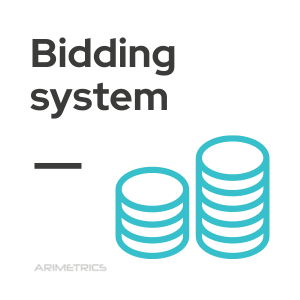Definition: 
Bidding systems allow companies to create bids for projects or services quickly and accurately with minimal effort. A bidding system saves time, reduces costs and ensures accuracy at all times. They are an automated solution that helps streamline the process while ensuring accuracy.
How the Bidding System works in Facebook Ads
Facebook Ads bidding is a sophisticated automated platform that allows businesses to create bids for products and services quickly and accurately. It takes factors such as user behavior, ad quality, performance, target audience, budget, and other criteria into account to determine the ideal bid amount.
The system works analyzing user behavior and automatically adjusting bids based on the performance of an advertising campaign. For example, if an ad performs well with high engagement rates, the system will adjust the bid amount accordingly to ensure maximum return on investment (ROI). In addition, the system can also detect ads that are not working as well and reduce them to save budget costs.
The bidding system is designed to save companies time, reduce costs and maximize return on investment. With its sophisticated algorithms and advanced technology, companies can trust that their offerings are always up-to-date and accurate. As a result, the bidding system helps companies increase efficiency while ensuring accuracy at all times.
How the Bidding System works in Google Ads
Google Ads bidding is an automated platform that allows businesses to create bids for their campaigns quickly and efficiently. It uses a variety of data points and advanced algorithms to create bids based on the performance of an ad campaign.
For example, the system takes into account historical performance data, cost per click (CPC), target audience, and other criteria to determine the ideal bid amount. It then automatically adjusts bids based on the performance of an ad campaign, ensuring maximum return on investment (ROI).
Google Ads bidding is designed to save businesses time and reduce costs, while maximizing return on investment. Thanks to it, companies can create accurate and up-to-date offers. As a result, it helps businesses increase efficiency while ensuring accuracy at all times.
How ads are prioritized with bidding systems
A bidding system uses advanced algorithms and data points to prioritize ads based on their performance. The system takes into account factors such as cost per click (CPC), user behavior, click-through rate (CTR), target audience, and other criteria to identify the best campaigns to show ads.
The algorithms used by the bidding system are designed to ensure that the best performing ads are prioritized. This helps businesses maximize return on investment while ensuring their ads are always seen by the right people. Bidding systems are essential for any business looking to optimize their advertising campaigns.
Types of bidding systems
- Manual bidding system: A manual bidding system requires the user to manually enter their bids on a regular basis. This type of system is time-consuming and error-prone as it is not automated.
- Automated bidding system: An automated bidding system allows users to set up an algorithm that will automatically adjust bids for them based on certain criteria such as cost-per-click (CPC) or click-through rate (CTR). Automation helps save time, reduce costs, and maximize return on investment by achieving higher performance goals.
- Real-time bidding (RTB): This type of bidding system uses real-time data from online auctions to determine real-time bid amounts for ads targeted to specific audiences or keywords. It is often used by advertisers who want to target more specific audiences with more accurate ads at the right times, making it a very powerful tool to maximize ROI when used correctly.
- Ad exchange platforms: Ad sharing platforms provide businesses with access to a large pool of potential customers across multiple ad networks simultaneously, while allowing businesses to manage campaigns across different ad networks without having to create separate accounts for each separately. These platforms also track metrics like cost per click or return on investment (ROI) to help businesses make decisions about which campaigns best suit their needs.
